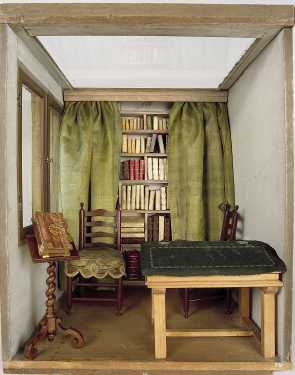In the small mezzanine / hanging room. Room
H
 Functiom
of this room: Small room or mezzanine, which was hung from the
ceiling beams. It could be reached through a trap door in the floor
and ladder goiong down to the small room G which was directly below
on the ground floor level, off the Great Hall. In winter heat from
the fire of the Great hall rose through the trap door
(Fock, 2001, p. 29).
Functiom
of this room: Small room or mezzanine, which was hung from the
ceiling beams. It could be reached through a trap door in the floor
and ladder goiong down to the small room G which was directly below
on the ground floor level, off the Great Hall. In winter heat from
the fire of the Great hall rose through the trap door
(Fock, 2001, p. 29).
Inventory: "A chest painted red, een roo geschilderde kist
; A foot rest, een voet
banckie ; Two meat tubs, twee
vlees kuypen ; 5 or 6 old books,
5 a 6 oude boucken ; Three small paintings in black frames,
drye kleyne stuckiens schilderij in swarte lysten ; An old
suitcase wherein seven copper
candle holders, een out koffer ende daerin bevonden seven
kopere kandelaars ; A small copper
kettle, een koper keteltie ; An iron
grill, een yseren rooster ; A pair of prongs,
een tang ; Three iron spoons
for [?], drye ysere slicklepels."

See the original documents from the Delft Archives. Goods owned by
Catharina Bolnes, page 1,
page 2, page 3,
page 4, page 5,
page 6, page 7.
Goods jointly owned by Catharina Bolnes and Maria Thins, page
1, page 2,
page 3, page 4,
page 5, page 6.

Illustration on top shows a small room from the Oortman Dolls
house, Rijksmuseum, Amsterdam.
Note : These objects were part of the
Vermeer-inventory as listed by the assistant of Delft notary public
J. van Veen on February 29, 1676, in the Thins/Vermeer home located
on Oude Langendijk on the corner of Molenpoort. The painter Johannes
Vermeer had died there at the end of December 1675. His widow
Catherina and their eleven children still lived there with her mother
Maria Thins.
The transcription of the 1676 inventory, now
in the Delft archives, is based upon its first full publication by
A.J.J.M. van Peer, "Drie collecties..." in Oud Holland 1957,
pp. 98-103. My additions and explanations are added in square
brackets [__]. Dutch terms have been checked against the
world's largest language dictionary, the Dictionary of the Dutch
Language (Woordenboek der Nederlandsche Taal , or WNT),
which was begun by De Vries en Te Winkel in 1882.
C. Willemijn Fock, Titus M. Eliëns,
Eloy F. Koldeweij, Jet Pijzel Dommisse, Het Nederlandse interieur
in beeld 1600 - 1900, Waanders, Zwolle, 2001, p. 29.
This page forms part of a large encyclopedic site on Vermeer and Delft. Research by Drs. Kees Kaldenbach (email). A
full presentation is on view at johannesvermeer.info.
Launched December, 2002; Last update March 1, 2017.
Back to the Welcome page: click Welcome.
 Functiom
of this room: Small room or mezzanine, which was hung from the
ceiling beams. It could be reached through a trap door in the floor
and ladder goiong down to the small room G which was directly below
on the ground floor level, off the Great Hall. In winter heat from
the fire of the Great hall rose through the trap door
(Fock, 2001, p. 29).
Functiom
of this room: Small room or mezzanine, which was hung from the
ceiling beams. It could be reached through a trap door in the floor
and ladder goiong down to the small room G which was directly below
on the ground floor level, off the Great Hall. In winter heat from
the fire of the Great hall rose through the trap door
(Fock, 2001, p. 29).
